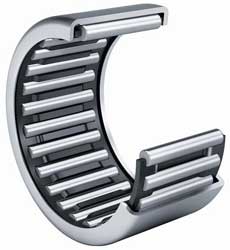
Posted to News on 20th Nov 2010, 16:50
Schaeffler needle roller bearings - 60 years of success
The basic design of a needle roller bearing has changed little in the last 60 years, but continuous developments have resulted in new cage designs that provide five times the service life and double the static load rating of their original counterparts.

Most design engineers will already be familiar with the needle roller bearing's ability to handle relatively high loads in a compact design envelope. This technical advantage has made the needle roller bearing the preferred choice of bearing in a wide variety of industrial and automotive power transmission applications over the years.
A typical needle roller bearing comprises an inner race (or sometimes just a shaft), a needle cage, the needle rollers and an outer raceway. There are many different designs of needle roller bearing, including drawn cup, precision race, caged roller, and thrust roller. Here, we consider the caged roller type in which a cage guides and retains the rollers. Caged designs normally come in single- and double-row designs, with a wide variety of cage materials being available, including steel, plastic (PA66) and aluminium. Multiple-row bearing designs boost load carrying capacity. Cages, whether steel or plastic, can be made in a variety of different constructions, including solid cage, single split and split halves (two-piece). These cages can also incorporate lubrication passages and other custom designed features. Caged needle roller bearings are therefore able to achieve high speeds and low friction.
Design considerations
Regardless of which type of the four main types of needle roller bearing is selected for an application, engineers should consider a variety of factors before making their decision as early in the design phase as possible: the size/design envelope, type of load, load capacity, speed, temperature, misalignment, housing and shaft specifications, service life and lubrication requirements.
During the early years, INA's development was closely linked with the automotive industry. Today, INA needle roller bearings are manufactured in more than 15,000 variants, with new designs customised to meet the special requirements of customer applications.
Machined needle roller bearings form the core of the INA range, particularly with the recent introduction of Schaeffler's X-life premium quality standard. Needle roller bearings produced to X-life quality now offer a 13 per cent increase in dynamic load rating compared to conventional bearings, which corresponds to a 50 per cent increase in service life.
For the customer, these improvements mean less lubricant stress, reduced friction and lower bearing temperatures, which, in turn, results in a more energy-efficient bearing. Furthermore, the increase in performance capacity enables the bearing to be downsized for the application, with corresponding reductions in the weight of the bearing and its space requirements.
Automotive gearbox application
In the unlikely event that application requirements exceed even X-life bearings, further technical performance improvements can be gained through the use of new bearing coatings and materials. One project currently being undertaken at Schaeffler's Automotive Division involves the redesign of a high-speed planetary gear set for an automatic gearbox transmission on a new hybrid electric passenger vehicle.
Stewart Davies, a Senior Application Engineer at Schaeffler (UK) Ltd, comments: "The automotive industry today is under increasing pressure to produce more fuel-efficient vehicles with lower CO2 emissions. One method of achieving this is to improve the fuel consumption of the vehicle by reducing friction across the complete drive train. This means reducing the weight of the overall vehicle by reducing the weight of individual components.
"Auto manufacturers now require bearings and other engine components that provide better friction characteristics, and so this is where the advantages of the caged needle roller bearing comes into play."
Davies says that a special design of cage for the needle roller bearing and improved features that improve the bearing's lubrication flow characteristics have resulted in a design of bearing with lower friction, which has enabled the customer's planetary gear set for the electric differentials to be reduced in size, weighing 17 per cent less than the original system. The bearings, in combination with optimised oil flow through the carrier, have enabled 20 per cent higher running speeds (up to 8000rpm).
Davies states: "The cage was custom-designed for the application. Due to a restricted design envelope, the cage needed to be smaller to accommodate the shaft and the housing bore of the gear is finished to support a bearing raceway. If not, an outer or inner ring would have been required."
Precession cages
Originally, cages were designed simply to guide the rolling elements. However, more recently, needle roller bearings are being provided with much-improved cage designs, including for example, special precessed cages.
Precession not only helps spread wear among all the rollers, but also distributes lubricant around the bearing. 'False brinelling' is a typical failure mode for caged needle roller bearings, particularly in power transmission applications. These failure modes are commonly caused by micro vibration and movements between the rolling elements and the raceway journals, creating metal-to-metal contact conditions.
The result of improvements such as those outlined above has led to the latest caged roller bearing designs being able to offer up to 25 per cent higher static load capacities for a similar size bearing, which equates to more than double the dynamic load rating. For applications with multiple small movements, bearing life typically increases from three to five times.
For more information on Schaeffler's range of needle roller bearings, go to www.schaeffler.co.uk, telephone the marketing department on +44 (0)121 313 5870 or email [email protected].






























